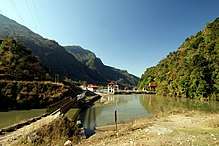Renewable energy in Nepal
Renewable energy in Nepal is a sector that is rapidly developing in Nepal.[1] While Nepal mainly relies on hydroelectricity for its energy needs, solar and wind power is being seen as an important supplement to solve its energy crisis.

Nepal is one of three countries with the greatest increases in electricity access from 2006 to 2016, owing to grid-connected and off-grid renewables.[2]
Hydropower
According to one estimate, Nepal has a hydropower potential of 83,000 megawatts (MW).[3] Harnessing an estimated 40,000 MW is considered technically and economically feasible.[4]
Nepal currently has an installed capacity of 1,000 MW coming from 88 hydropower plants across the country.[5] Of this, 441 MW is produced by 60 hydropower plants owned by independent power producers.[5] Most of Nepal's hydropower plants are run-of-the-river, which causes electricity supply to fluctuate according to the season.[5]
As of March 2018, as many as 113 hydropower plants are under construction. These plants will have a combined capacity of 3,090 MW once completed.[5]
The Nepal earthquake in April 2015 is estimated to have destroyed at least 14 hydropower dams in the country,[6] accounting for 115 MW of hydropower facilities.[7] The earthquake affected 30 percent of Nepal's generating capacity at the time.[8] This resulted in suggestions for Nepal to diversify it energy mix, as well as for "short, medium and long-term energy planning to have reliable, secure and sustainable electricity provided to households, businesses and industries in the country."[7]
Solar energy

Nepal gets most of its electricity from hydropower sources, but it is looking to expand the role of solar power in its energy mix.[9]
Power cuts with an average of 10 hours per day in the past time[10] had been common in Nepal and Nepal Electricity Authority[11] used to publish a time table for power cuts. Solar energy can be seen as a more reliable source of energy in Nepal than the traditional electricity. Private installations of solar panels are more frequent in Nepal.
Accordingly solar energy are used properly in Nepal but we can still improve more.
The People living in places such as Madi, Chitwan, where the Electricity Authority does not provide electricity[12] because of Chitwan National Park, have been relying on solar power[13] for several years.
Nepal began construction of its largest solar energy plant in April 2018 in the Nuwakot district. The project will have a capacity of 25 MW to serve the Kathmandu valley upon completion.[14][15]
In 2019, Nepal's Department of Electricity Development approved survey licenses for 21 locations to prepare for the possible installation of 56 solar plants, which could have a combined solar capacity of 317.14 MW.[9] The largest planned solar energy project is a 120 MW solar PV station in Dhalkebar in Mahottari district.[9]
Wind-solar energy
Nepal launched its largest wind-solar power system in December 2017 to serve rural households in the Hariharpurgadi village, Sindhuli district, under the South Asia Subregional Economic Cooperation Power System Expansion Project.[16] The system has the capacity to produce 110 kilowatt-hours of energy per day.[16]
The country also operates a mini-grid wind-solar system in rural village of Dhaubadi the Nawalparasi district, which supplies 43.6 kilowatt-hours of energy per day.[17]
Electric vehicles
Electric powered[18] public three wheeler have been in use to reduce carbon dioxide (CO2) emissions. [19]
See also
| Wikimedia Commons has media related to Renewable energy in Nepal. |
- Renewable energy in Asia
- Kaligandaki A Hydroelectric Power Station
- Bhote Koshi Project
References
- "The age of enlightenment". Nepalitimes. Retrieved 3 February 2013.
- Mackres, Eric; Mentis, Dimitrios; Qehaja, Anila (February 15, 2019). "Bhutan has achieved 100% electricity access. Here's how". World Economic Forum. Retrieved 2019-04-01.
- "First man to predict 83,000 MW hydropower potential in Nepal passes away". Kathmandu Times. April 28, 2017. Retrieved 2018-04-06.
- Bhushal, Ramesh (2016-11-24). "Nepal is diversifying its renewable energy mix". The Third Pole. Retrieved 2019-04-01.
- Adhikari, Devendra (March 18, 2018). "Hydro-powered dreams". Kathmandu Post. Retrieved 2018-04-06.
- "Nepal Earthquake Damages At Least 14 Hydropower Dams". Circle of Blue. 2015-05-05. Retrieved 2018-04-06.
- "Diversity in power". Kathmandu Post. March 11, 2018. Retrieved 2018-04-06.
- "Nepal Earthquake Damages At Least 14 Hydropower Dams". Circle of Blue. 2015-05-05. Retrieved 2018-04-06.
- Subedi, Bibek (March 17, 2019). "Role of solar in Nepal's energy mix looks set to expand". Kathmandu Post. Retrieved 2019-04-01.
- "Load Shedding Schedule . (Nepali)" (PDF). Nepal Electric Authority. Retrieved 4 February 2013.
- "Loadshedding Schedule". Retrieved 3 February 2013.
- "Madi to receive electricity at last". 2012-12-10. Retrieved 4 February 2013.
- "Harnessing the sun to protect people and wildlife". Retrieved 4 February 2013.
- "Work begins on Nepal's largest solar plant". Kathmandu Post. April 28, 2018. Retrieved 2019-01-03.
- "Nepal breaks ground on 25-MWp solar project". Renewables Now. May 1, 2018. Retrieved 2019-01-03.
- Bank, Asian Development (2017-12-12). "Nepal's Largest Wind-Solar Hybrid Power System Switched On to Connect a Small Village to the World". Asian Development Bank. Retrieved 2019-01-03.
- "AEPC gets $3m ADB grant to install 10 power plants". Kathmandu Post. December 23, 2017. Retrieved 2019-01-03.
- "Electric Vehicle in Kathmandu Nepal". Retrieved 3 February 2013.
- "A cleaner, greener Nepal MYREPUBLICA.com - News in Nepal: Fast, Full & Factual, POLITICAL AFFAIRS, BUSINESS & ECONOMY, SOCIAL AFFAIRS, LIFESTYLE, SPORTS, OPINION, INTERVIEW, INTERNATIONAL, THE WEEK news in English in Nepal". 2012-07-31. Retrieved 3 February 2013.